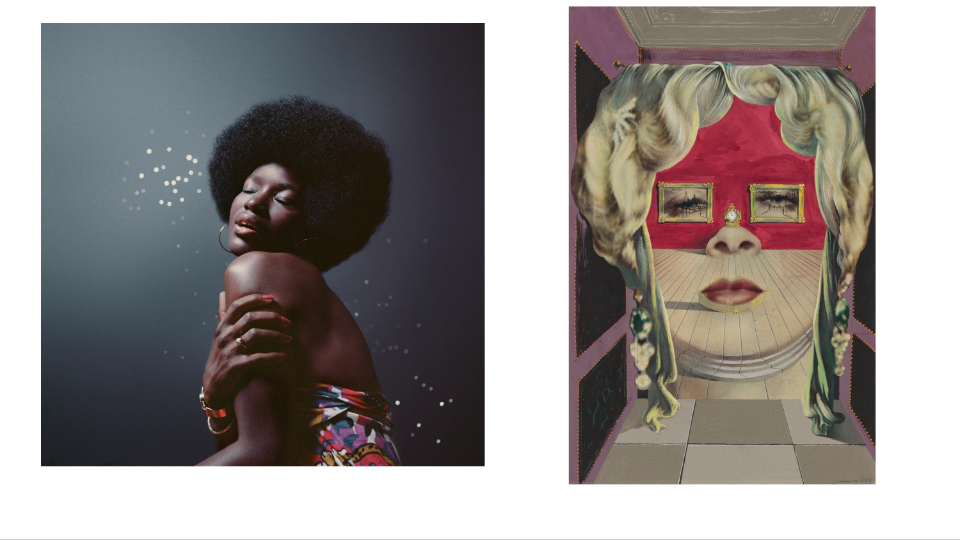
CHICAGO — Salvador Dalí: The Image Disappears is the high-powered draw at the Art Institute these days, attracting large crowds, through June 12, to examine the surrealist’s work of the 1930s, the critical decade of the Spanish Civil War. He had already become celebrated enough as an iconic representative of his age, and of a certain provocative esthetic, to be invited to create covers for Vogue magazine and to design a pavilion at the New York World’s Fair of 1939.
Anyone who knows Dalí recalls his melting clocks and pianos, his statement to the world that our very senses, not to mention our social and political assumptions, are subject to what might later be called radical “psychedelic” transformation.
As we wended our way toward Dalí, housed in two galleries and featuring three or four dozen of his works, some in the museum’s collection and others borrowed, we visited a couple of other exhibitions and passed through just a few of the Art Institute’s endless series of grand halls. And something quite amazing occurred to me, though I know from a professional art historian’s point of view, this is no news.
Images have been “appearing” and “disappearing” for a long time, before and since Dalí. En route to the Dalí show, we passed through the Art Institute’s substantial galleries of Impressionism (the dominant esthetic, I should observe, at the time the great Chicago industrialists who had money to burn visited Europe and bought out the ateliers). Among the works one could spot on that hike are Claude Monet’s famous haystack series: The same haystacks standing out in the field like oversized bran muffins, but segments of them “appearing” and “disappearing” according to the hour and angle of the sun.
Also at the Art Institute is one of the most famous and deeply loved paintings of all time: Georges Seurat’s large-scale A Sunday Afternoon on the Island of La Grande Jatte, completed in 1886. How well the artist knew that, using his technique of pointillism, just a few dots of darker pigment here, or a lighter one there, and he could evoke shadows, textures, reflections, and the shifting shimmer of light and water.
Photography was one of the revolutionary mediums that emerged in the 19th century, and artists were both inspired and threatened by it. For some, it spelled the death of art, yet for others, it opened up unending vistas of possibility. Seurat’s pointillism certainly shares some esthetic ground with the pixelization of photography—perhaps even inspired by it.
As art historians have lately taken to speculating, the very “impressionistic” look of the cityscape in 19th-century art could well be not simply an artist’s conceit (or eyesight) but the prevalence of smog, dust, and smoke particulate in the air—unregulated pollution a progenitor of art.
Could it be that the conclusions of Charles Darwin are at play here in artists’ understanding of how things “appear” and “disappear?” Certain life forms come into existence because of climatic change or the introduction of new species—and similarly go extinct because of disease, loss of dietary support, overhunting, or catastrophe.
And then there’s our dear Prof. Marx, who wanted to dedicate his monumental three-volume Capital to Darwin—who declined the honor—in homage to the theory of evolution, which so informed Marx’s own “science” of dialectical materialism, a construct of history as similarly always changing, evolving according to technological progress, movements of population, means of production, and shifts in class relations.
With these ruminations in mind, I headed out to view the two exhibitions featured on the Art Institute’s website that had piqued my interest before leaving for Chicago.
Worth waiting for Kwame Brathwaite
Kwame Brathwaite: Things Well Worth Waiting For. The very title of this exhibition also asks us to think of this seminal African-American photographer through the lens of time, over the course of seven decades. It’s on view through July 24. His name may not be familiar to many, but his work has impacted the worlds of music, fashion, and political consciousness.

Brathwaite’s career started through music in the mid-1950s, when he co-founded a group called African Jazz-Art Society and Studios (AJASS). Over time, as the “Black is Beautiful” esthetic emerged alongside the civil rights movement, and later the Black Power movement, he assembled fashion shows and concerts that featured African culture, and heritage at a time when Black models could rarely be seen in, uh, Vogue and almost all the other fashion media. Western ideals of beauty became subverted under his eye. His continued interest in music led him to document the leading performers of his day, both in written reviews and in photography. He is well known for his album covers. His project was always to record “the essence of Black experience, as a feeling, a drive, and an emotion” as expressed in Black music.
The exhibition title derives from Brathwaite’s published review of the 1976 album Songs in the Key of Life, perhaps Stevie Wonder’s most iconic, personal and representative.
One item in the exhibition is a short video of a Black fashion show with models parading and voguing in their exuberant designer outfits. Most of them are quite “dated” now—only someone consciously trying to recall that period would wear such things now. But then, that is also true of the style of any period. Who wears a toga now? A Lord Fauntleroy suit? What lady appears with a trendy bustle as seen in Seurat’s Sunday Afternoon? They have all disappeared, along with the passenger pigeon, only reappearing as film and theater costumes.
Brathwaite himself formally retired in 2018, the year of his 80th birthday. His family has undertaken the job of cataloging his vast archive. A good portion of this exhibition is now being shown again after, in many cases, over half a century. Kwame Brathwaite: Things Well Worth Waiting For is curated by Grace Deveney, David C. and Sarajean Ruttenberg Associate Curator, Photography and Media.

The future of nuclear landscapes
Indian artist and writer Himali Singh Soin is featured at the Art Institute, through May 15, in Static Range, her first solo exhibition in the U.S. The project, which is still ongoing, encompasses history, geography, national pride, text, photography, philately—and over half a century’s worth of nuclear drift. The half-life of nuclear contamination suggests that if her descendants were to take up her project after Soin is gone, we might be seeing updated exhibitions on it for the next 15,000 years. One hopes the Art Institute of Chicago will still be there.
“The story begins,” according to the Art Institute, “with an act of Cold War espionage. In 1965, the CIA and the Indian Intelligence Bureau collaborated to install a plutonium-powered spy device on Nanda Devi, patron mountain of the Indian Himalayas, to intercept Chinese nuclear missile data. A terrible storm interrupted the mission, and the device was abandoned on the mountainside. It has never been found, yet its invisible environmental fallout endures.”
Thirteen years later, Soin’s father joined a mountaineering expedition and photographed this “patron mountain” of Nanda Devi. One of his photographs was later adapted into a national postage stamp—thus the philatelic connection. With that, the ticking nuclear landscape not only continued sending its issue to the world but also began to transmit data and news through the mail.
Static Range carries a cascade of double meanings. One thinks of a mountain range as static, though as the Gershwin Brothers reminded us in their 1938 song “Love Is Here to Stay,” “In time the Rockies may crumble, Gibraltar may tumble.” Numberless volcanoes, landslides, and commercial mining’s mountaintop removals also confirm that a range might not be so stable as it first appears. And then there’s that “plutonium-powered” static that’s been ticking off the Himalayas since 1965. How widely does that pollution range? Those Himalayan winds surely continue to touch everywhere on Earth, not to mention emanations from all the other nuclear sites in the world.
The mountain, to Soin, is “a canvas for speculations and reflections about nuclear culture, porosity, leakages, toxicity and healing, spiritual-scientific entanglements, environmental catastrophe, and post-nation states.” Her Static Range brings together all this public and intimate history in an immersive, multi-media environment involving poetry, music, video, draped and floor textiles, ceramic, works on paper, and a therapeutic garden.

In keeping with the philatelic theme, Static Range also features the edition of an artist stamp book, copies of which are available for “sampling,” with lickable, perforated paper images of her many pixelated variations on her father’s stamp design.
Video is the most prominent element of the exhibition, with constantly morphing versions of the mountain using Day-Glo colors to illustrate what airborne nuclear violence may be emanating from those heights out to the world. Her soft, Indian-accented voice has a kind of lulling, hypnotic effect as she reads poetic, sometimes only half-audible letters to us. Museumgoers are invited to stretch out on the floor with a pillow at their neck and absorb all this cool radiant multi-media effect.

In between the two large video screens, Static Range places Nanda Devi within a larger global web of nuclear sites, including the Lake District in England, Fukushima in Japan, and Chernobyl in Ukraine. The Art Institute also has not forgotten that Chicago has its own history as a critical research site for the Manhattan Project in the 1940s.
Static Range offers a rich assemblage of media, including artworks from the Art Institute’s collection. At its center is an enigmatic ceramic vase chosen for its resemblance to the Big Boy bomb, reminding us that ordnance from World War II, and from Cold War mines, are still exploding in far-flung erstwhile battlefields where people today are trying to get on with their lives. The exhibition was designed by the Chicago-based architectural office Future Firm in collaboration with the artist. Himali Singh Soin: Static Range is curated by Irene Sunwoo, John H. Bryan Chair and Curator of Architecture and Design.
On the way out, we met Cameron Mankin, an arts educator who was helping schoolchildren to make their own texts and drawings addressing ecological concerns in “conversation” with Soin’s work. We would have picked up some of his paper, pencils, and colored pens to see what we could respond to, but we had planes out of Midway to disappear on.
We hope you appreciated this article. Before you go, please support great working-class and pro-people journalism by donating to People’s World.
We are not neutral. Our mission is to be a voice for truth, democracy, the environment, and socialism. We believe in people before profits. So, we take sides. Yours!
We are part of the pro-democracy media contesting the vast right-wing media propaganda ecosystem brainwashing tens of millions and putting democracy at risk.
Our journalism is free of corporate influence and paywalls because we are totally reader supported. At People’s World, we believe news and information should be free and accessible to all.
But we need your help. It takes money—a lot of it—to produce and cover unique stories you see in our pages. Only you, our readers and supporters, make this possible. If you enjoy reading People’s World and the stories we bring you, support our work by donating or becoming a monthly sustainer today.










